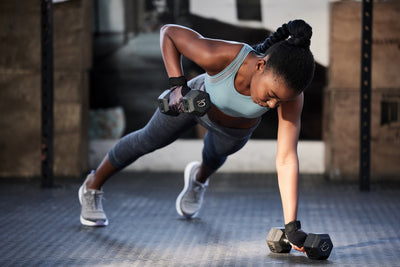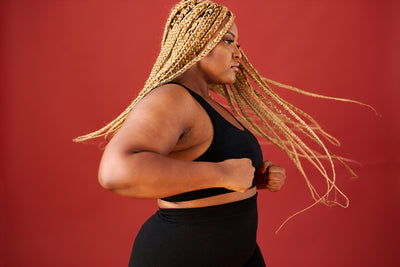Today, we're talking about something that might surprise you: how cannabis can take your non-equipment workouts to the next level. That's right, the green stuff isn't just for chilling on the couch anymore. It's a natural aid that can help you focus, ease pain, and even keep you cool during those intense bodyweight exercises. So let's dive in and explore the benefits of cannabis for your fitness routine, backed by scientific research [1][2][3][4][5].
CBD & THC for Pain
Working out can be a love-hate relationship. We love the results, but we're not always fans of the aches and pains that come with it. Enter cannabis. Research has shown that cannabinoids (like THC and CBD) interact with our body's endocannabinoid system, which plays a significant role in pain management [1][2]. These compounds can help reduce inflammation and provide relief from muscle soreness, both during and after your workout [2].
Imagine nailing that challenging yoga pose or smashing out a killer set of push-ups without wincing in pain. Sound too good to be true? It's not. Incorporating cannabis into your workout routine might just make those post-workout aches a thing of the past [1][2].
Cannabis for focus
Think cannabis only makes you spacey and unfocused? Think again. When used responsibly, it can actually help you hone your mental focus during your workout [4]. A little bit of cannabis can help you find that perfect mind-muscle connection, allowing you to concentrate on each rep and movement with laser-like precision [3][4].
But how does it work? Well, the endocannabinoid system also plays a part in regulating our cognitive functions [3]. Cannabis can help activate certain receptors in the brain, leading to improved focus and mental clarity [4]. So, the next time you need a little extra oomph to get through that grueling workout, consider giving cannabis a try [3][4].
Weed keeps you cool
Raise your hand if you've ever felt like a melting popsicle during an intense workout. Yep, we've all been there. But did you know that cannabis can help regulate your body temperature? It's true! THC, one of the primary compounds found in cannabis, has been shown to have a cooling effect on the body [5]. This can be especially useful during high-intensity workouts when our body's internal temperature starts to climb [5].
By helping to reduce your core body temperature, cannabis can make your workouts more comfortable and efficient [5]. No more feeling like you're about to burst into flames during those tough bodyweight exercises!
A Word of Caution
It's essential to remember that everyone's body is different, and what works for one person may not work for another. Start with a low dose, and always listen to your body. And, of course, make sure you're using cannabis legally and responsibly.
Importantly, we should note that cannabis should not be used when working with fitness equipment. The potential for impaired judgment, coordination, or balance can create dangerous situations when operating machines or handling weights. So, stick to non-equipment exercises when incorporating cannabis into your fitness routine.
So there you have it, folks! Cannabis isn't just for relaxing on the couch anymore; it's an all-natural aid to support your non-equipment workouts. With its ability to reduce pain, sharpen focus, and regulate body temperature, it's time to give this green powerhouse a spot in your fitness routine [1][2][3][4][5]. Just remember to keep it safe and stick to bodyweight exercises. Stay Elevated!
**These statements have not been evaluated by the Food and Drug Administration. This product is not intended to diagnose, treat, cure or prevent any disease.
***If you are pregnant, nursing, have any health conditions, or are taking any medications, consult your health practitioner before using this product. WARNING: Keep out of reach of children.
Sources:
[1] Russo, E. B. (2008). Cannabinoids in the management of difficult to treat pain. Therapeutics and Clinical Risk Management, 4(1), 245-259. [Link: https://www.ncbi.nlm.nih.gov/pmc/articles/PMC2503660/]
[2] Nagarkatti, P., Pandey, R., Rieder, S. A., Hegde, V. L., & Nagarkatti, M. (2009). Cannabinoids as novel anti-inflammatory drugs. Future Medicinal Chemistry, 1(7), 1333-1349. [Link: https://www.ncbi.nlm.nih.gov/pmc/articles/PMC2828614/]
[3] Gertsch, J., Pertwee, R. G., & Di Marzo, V. (2010). Phytocannabinoids beyond the Cannabis plant – do they exist? British Journal of Pharmacology, 160(3), 523-529. [Link: https://www.ncbi.nlm.nih.gov/pmc/articles/PMC2931553/]
[4] Broyd, S. J., van Hell, H. H., Beale, C., Yücel, M., & Solowij, N. (2016). Acute and chronic effects of cannabinoids on human cognition—A systematic review. Biological Psychiatry, 79(7), 557-567. [Link: https://www.ncbi.nlm.nih.gov/pubmed/26858214]
[5] Tantimonaco, M., Ceci, R., Sabatini, S., Catani, M. V., Rossi, A., Gasperi, V., & Maccarrone, M. (2014). Physical activity and the endocannabinoid system: an overview. Cellular and Molecular Life Sciences, 71(14), 2681-2698. [Link: https://www.ncbi.nlm.nih.gov/pubmed/24446007]






Leave a comment